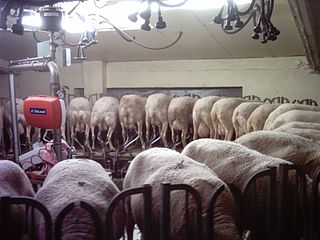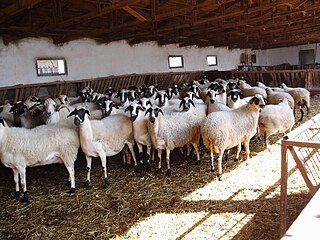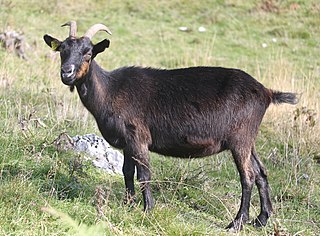The Dagliç is a breed of sheep found primarily in western Anatolia in Turkey. They are a carpet wool breed used for both meat and dairy production. Sheep of this breed typically have black spots on the head and legs. The rams are usually horned and the ewes are polled. The breed is thought by some to be the origin of the Chios and Kamakuyruk breeds.

Sheep's milk is the milk of domestic sheep. It is commonly used to make cultured dairy products such as cheese. Some of the most popular sheep cheeses include feta (Greece), ricotta (Italy), and Roquefort (France).

The St Croix is a breed of domestic sheep native to the U.S. Virgin Islands and named for the island of Saint Croix. They are often also called Virgin Island White because those that were imported into North America were selected for white coloration. On the Island of St. Croix, they come in shades of brown, white, and black.

Sheep or domestic sheep are domesticated, ruminant mammals typically kept as livestock. Although the term sheep can apply to other species in the genus Ovis, in everyday usage it almost always refers to domesticated sheep. Like all ruminants, sheep are members of the order Artiodactyla, the even-toed ungulates. Numbering a little over one billion, domestic sheep are also the most numerous species of sheep. An adult female is referred to as a ewe, an intact male as a ram, occasionally a tup, a castrated male as a wether, and a young sheep as a lamb.

The Lacaune is a breed of domestic sheep originating near Lacaune in southern France. The native region of these sheep is the Tarn and Aveyron departments and surrounding areas. This region is collectively known as the "Roquefort Sector" which references the milk collection area. The Lacaune is the most widely used dairying sheep breed in France, with a population of about 800,000 ewes. Notably, it is the predominant breed used in the production of Roquefort cheese in France.

The goat or domestic goat is a domesticated species of goat-antelope typically kept as livestock. It was domesticated from the wild goat of Southwest Asia and Eastern Europe. The goat is a member of the animal family Bovidae and the tribe Caprini, meaning it is closely related to the sheep. There are over 300 distinct breeds of goat. It is one of the oldest domesticated species of animal, according to archaeological evidence that its earliest domestication occurred in Iran at 10,000 calibrated calendar years ago.
The Bovec is a breed of domestic sheep from the upper valley of the Soča or Isonzo river, now in Slovenia. The breed is named in both Slovenian and in Italian for the town of Bovec or Plezzo; in the Trenta valley it may also be called Trentarka. It is raised in the Soča valley in Slovenia, in the areas of Resia and Tarvisio in Friuli in Italy, and in Styria and Carinthia in Austria. The breed is raised for milk and for meat.
The British Milksheep is a robust, dual-purpose sheep commonly known for its milking characteristics.

The Chios is a breed of domestic sheep with specific unknown origins. It is classified as a semi-fat tailed breed. The Chios are bred mainly for their milk production. Although there is speculation that this breed may have been crossed with Kivircik and Dagliç, it is commonly accepted that it originated on the Greek island of Chios.

The Comisana, also known as Faccia Rossa and Lentinese, is an Italian breed of domestic sheep indigenous to central and northern areas of the Mediterranean island of Sicily. Its name derives from that of the comune of Comiso, in the province of Ragusa. It is raised principally in the provinces of Caltanissetta, Enna and Palermo, but is found in many other Italian provinces and has also been exported to other Mediterranean countries.

The Latxa is a breed of domestic sheep native to the Basque Country of Spain. Mostly contained within the provinces of Biscay, Gipuzkoa and Navarre, Latxa are dairy sheep whose unpasteurized milk is used to produce Idiazábal and Roncal cheeses. There are two sub-types of the breed, a dark-faced and a blonde.
The Istriana or Carsolina, Croatian: 'Istarska Ovca', Slovene: 'Istrska Pramenka', is a breed of domestic sheep from Istria and the Karst regions of the northern Adriatic, from north-east Italy to Croatia and Slovenia.
The Savoiarda or razza di Cuorgné is a threatened breed of upland sheep from the province of Turin, in Piemonte, north-west Italy. The few remaining breeders are in the Val Chisone, the Val di Susa, the Valli di Lanzo and the Val Pellice.

The Massese is an Italian breed of domestic sheep from the Alpi Apuane mountains of the province of Massa Carrara, in Tuscany in central Italy. It takes its name from the town of Massa. It is raised throughout most of Tuscany, and also in Emilia–Romagna, Liguria and Umbria. It has common origins with the other indigenous sheep breeds of the Apennines.
The Gentile di Puglia is a breed of domestic sheep indigenous to southern Italy. It originates from the Tavoliere di Foggia, a large plain in the northern part of Puglia, and is raised mainly in that region; a few are found in neighbouring regions. The Gentile di Puglia is sometimes known as the Merinos d'Italia, or Italian merino.
The Delle Langhe, also called Pecora delle Langhe or Langarola, is a breed of domestic sheep indigenous to Piedmont, in north-western Italy. It is a rough-woolled breed of southern Mediterranean type, and originates from the mountainous area of the Alta Langa, where the Apennines meet the Alps, in the province of Cuneo. It is raised mainly in the Langhe, but is found in several other regions of Italy including Abruzzo, Basilicata, Emilia–Romagna, Liguria and Tuscany.

Goat farming involves the raising and breeding of domestic goats as a branch of animal husbandry. People farm goats principally for their meat, milk, fibre and skins.

The Rouge du Roussillon is an endangered breed of sheep from southern France. It is primarily raised in the French Mediterranean countryside for lamb meat.

Drežnica goat is an autochthonous breed of goat, originating in Slovenia, Posočje. Currently it is the only goat breed being listed among Slovenian either autochthonous either traditional breeds of domestic animals. Animals of this breed are middle-sized darker goats, that are being used both for production of milk and dairy products as well as obtaining goat meat.












